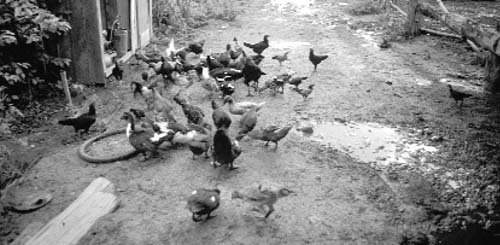
Understanding how farming households meet their needs is essential to assess the likely adoption of fish culture. A study of the evolutionary development of farming systems provides a useful framework since the nature and intensity of farming activities may indicate the likelihood of fish culture being appropriate. We analyse the factors that have stimulated intensification of farming and relate this to prospects for integration of livestock and fish production. Agricultural development has been linked to the pressures of human population growth and we also examine this effect, together with the impacts of changes caused by urbanization and industrialization.
A schema of the possible evolutionary development of integrated farming systems is given in Figure 5. Settled agriculture is divided into three phases to indicate the potential role of integrated farming, particularly with respect to smallholder farmers in less developed countries (LDCs). Pastoral nomadism and shifting cultivation have limited aquaculture potential. Pastoral systems occur in arid regions in which seasonal availability of grazing limits carrying capacity of livestock and nomadism is a necessary part of a livelihood strategy. This movement of both pastoralists and shifting cultivators has necessarily constrained development of fish culture. The limited extent and duration of surface waters in arid regions also constrains natural fish production; and fish consumption is usually unimportant or absent among peoples living in such areas. Harvesting wild stocks generally remains important for aquatic foods after settled agriculture is well developed, whereas hunting and gathering terrestrial food declines rapidly as agriculture evolves.
The evolutionary development of both livestock and fish production can be classified within a schema derived from the same broader farming systems context (Figure 6). Settled agriculture I is typical of many pre-industrial societies where there is little integration between crops and livestock managed principally for draught and to meet social obligations. If fish culture occurs it is normally at a very extensive level and closely associated with management of wild fish stocks. In settled agriculture II, the production of livestock and crops are more intimately linked, with livestock fed on crops and crop by-products and their manure essential for maintaining soil fertility. Use of N fixing plants together with other inputs such as nightsoil is also a common strategy for maintaining productivity. It is in this context that most traditional integrated fish culture is found. The trend towards industrial monoculture (settled agriculture 3) is a model followed by both livestock and fish production and is widely adopted in developed economies. Recently however, environmental concerns about heavy use of agrochemicals and waste disposal, consumer pressure and legislation are leading to some return to a more balanced approach to food production.
The tendency to develop more intensive farming systems that produce more food per unit area per unit time has traditionally been linked to increasing population pressure. Global population is expected to rise further from the current level of 6 billion, and may double before stabilizing, even at the most optimistic projections. Global population is split more or less equally between urban and rural areas but urban areas are expected to surpass rural area in population around the year 2005 and to account for 60 percent of the total by 2020 (UN, 2000).
Population pressure has not occurred, nor exerted its impact on intensification of food production evenly. Historically more fertile, well-watered environments have had greater productive potential and supported higher human populations. Thus, well-endowed floodplain agroecosystems in Asia have become the site of the most intensive traditional agricultural practices. Globalization of trade pre-dating the colonial era, industrialization and major changes in human medicine have fundamentally de-linked food production and human population densities. If the concept of agro-climatic population, or the population in terms of food production capacity is used, today semi-arid zones are typically under much greater population pressure relative to land endowments than humid areas (Binswanger and Pingali, 1988). Although historically most of Africa has had little pressure on land resources, by 2025 the majority of the continent will comprise high-density countries requiring highly productive agricultural techniques.
FIGURE 5
Evolutionary development of integrated farming systems.
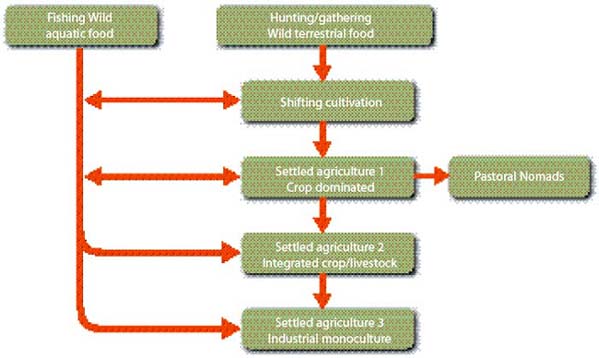
Source: Modified after Edwards (1997)
FIGURE 6
Classification of livestock production and relationship to value of livestock waste for aquaculture
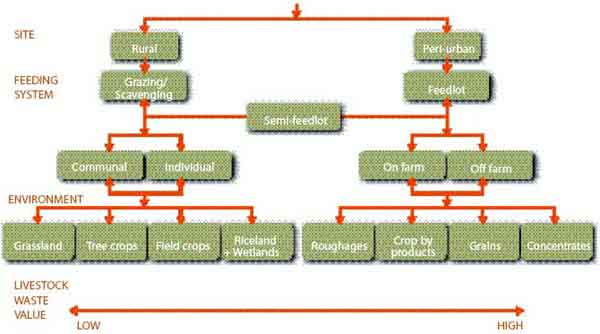
Source: Little and Edwards (1999)
Accelerating urbanization has stimulated demand for industrial food production in both developing and developed countries. Industrial food production requires intensive applications of resources, particularly energy, nutrients and water and is dependent on scientific knowledge. Farming operations spanning a wide range of intensity levels can be found increasingly within the same country although some doubt that coexistence of less intensive production systems with industrial methods is possible over the long term. Integration of livestock and fish, in which one or both subsystems does not become entirely agro-industrially based, may better fit the limited resource base of smallholders and improve environmental sustainability.
Environments have shaped cultures and dietary norms and taboos that in turn explains current distribution and dependence on livestock and fish. Recent anthropological research has shown that the concepts of the ‘sacred’ cow and ‘abominable’ pig have an environmental basis (Harris, 1997). The advantages of ruminants that digest cellulose and thus do not compete for food with humans, together with their more multipurpose attributes, are the bases for the cultural bias. The rejection of fish as food is also common among people in arid environments where surface water and natural stocks of aquatic animals are rare. The lack of large livestock in traditional slash and burn-based societies in Africa, and elsewhere, can be related to a low requirement for tillage, and their poor survival because of the tsetse fly (Binswanger and Pingali, 1988). Animal protein needs could be met by the harvest of game and wild fish and intensification of livestock and fish production was unnecessary (Little and Edwards, 1997) at the low human population densities found in typical swidden agricultural societies.
If natural supplies of wild stocks are particularly rich, much higher population densities may be supported, provided human dietary energy needs are met. The rice-fish societies of lowland Asia are good examples of this situation where diets based on cultured, calorie-rich rice were balanced by diverse, aquatic plant and animal food gathered from the floodplains. Indeed, whilst natural fish supplies remain adequate, there is little interest in fish culture (Gregory and Guttman, 1996). Seasonal inundation of flood plains that led to dependence on aquatic-based food sources probably also limited the importance of livestock because of seasonal shortages of feed.
In contrast, arid environments have stimulated pastoral systems in which low densities of ruminant livestock are grazed on extensive, common property pastures. The challenges associated with increasing productivity in such marginal, community-based resources systems are similar in both water-short, livestock-based pastures and water-rich, communally exploited wetlands. Major issues include how intensification can occur whilst safeguarding equity and the environment (Table 2.1).
In contrast to most shifting farming, in which livestock is relatively unimportant, or pastoralists in which livestock dominate, animals fulfil small but important roles within the household in settled agriculture. Furthermore, settled agriculture has much greater potential for aquaculture. Most land is reserved for crops and livestock are kept mainly for draught in settled agriculture phase I. Pigs and poultry may also be kept in small numbers, and usually scavenge and are fed wastes from the household. There is little integration between crops and livestock, largely because the number and nutritional status of the livestock are low. Ruminants depend mainly on limited rough grazing of harvested fields and common land. Limited crop diversity, as well as little recycling of crop residues and manures, are characteristics of crop-dominated systems. Such resource-poverty is typical of most small-scale farmers in developing countries today, except those that have leapfrogged to settled agriculture III through the green revolution. Crop-dominated systems include crops grown as the dietary staple such as rice and maize, often for subsistence, together with other crops grown for cash. Various levels of intensification may be evident e.g. irrigation, terracing, fertilization and weeding. Orchard crops and vegetables are often grown in home gardens.
In some parts of the developing world, such as Southern Viet Nam, both livestock and fish are relatively important even in crop-dominated livelihoods (Ogle and Phuc, 1997) but the potential is far from realised by most households which rely mainly on wild fish. One survey indicated that farms in Central Thailand, which had diversified away from rice monoculture were more likely to use animal waste for fish culture than farms continuing to concentrate on rice production (Figure 7). Such intensification of livestock in settled agricultural phase I is often limited by poor feed availability. Also, draught animals tend to be used irregularly so although their productivity is low, farmers have little interest in improving their performance. Parallel development of intensive feedlot operations may also reduce opportunities for small-scale pig and poultry production (Little, 1995).
Widespread adoption of fish culture may not have occurred within crop-dominated systems, even when fish are valued and consumed. Stocks of wild fish may remain at a level that satisfy rural peoples’ needs. Poorly developed on-farm water storage, or a lack of seed or knowledge may also constrain adoption. Traditional aquaculture in the valleys of upland areas of Indochina and Southern China, where population densities are high and wild fish stocks are very limited, suggest that aquaculture can evolve under these conditions, but that linkages between livestock and fish were relatively weak. Intensification of fish production based on animal manures would be constrained by the limited numbers of livestock and difficulties in collection and use of their waste. Livestock diseases also constrain inventories of livestock in many instances (Box 2.A)
TABLE 2.1
Comparison of common property management and scope for intensification in water-scarce and flood-prone environments
|
Environment |
|||
|
Characteristic |
Water-scarce |
Flood-prone |
Notes |
|
Dominant livelihood strategy |
|
|
|
|
Density and yield area-1 |
|
|
|
|
Stock and habitat enhancement |
|
|
|
|
Indigenous species |
|
|
|
|
Challenges to sustainability |
|
|
|
|
Challenges to equity |
|
|
|
|
BOX 2.A Disease constrains livestock production Aquaculture is a recent development among certain ethnic minorities, such as the Hmong in upland areas of Indochina, for whom pig production is both traditional and important. Under current conditions disease is a greater constraint to expansion of pig production than feed availability; more arrowroot or cassava can be grown, or vegetables and banana stems cut from the forest, if supplies of maize are limited. Pig wastes are used extensively, with wastewater directed towards opium-poppy growing plots, but the siting of pens over fish ponds has been adopted by some households. Source: Oparaocha (1997) |
FIGURE 7
Percentage of farms in Central Thailand using various fertilizer and supplementary feed inputs for fish culture (a) manure (b) rice and grain products (c) waste food from human consumption and agro-industry (d) animal by-products and animal feed (e) vegetable matter
(a)
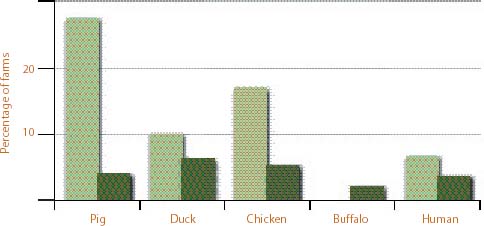
(b)
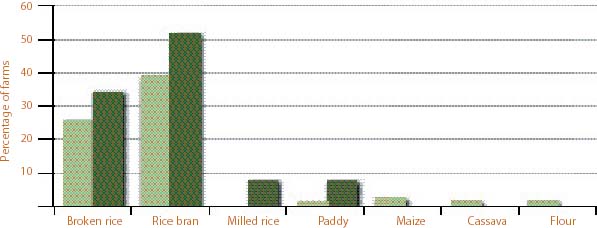
(c)

(d)
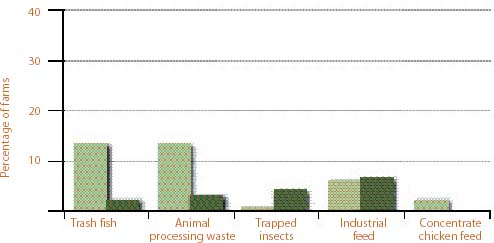
(e)
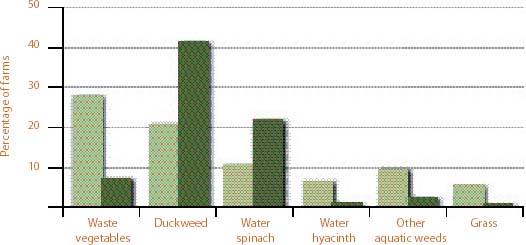

Source: AIT (1983)
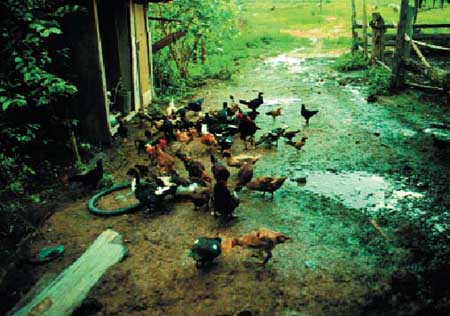
Small flocks of mixed poultry, allowed to scavenge for natural feed and given small amounts of supplementary feed such as paddy grain or ricebran, are common in Asia
The integration of livestock with crops, or mixed farming, is the major characteristic of settled agriculture phase II. Livestock fed arable crops and improved pasture produced on the farm is the main focus. Crops are intimately integrated with livestock as manures are used to maintain soil fertility together with N fixing legumes. Much of the farming in Western Europe and Eastern USA was of this type between 1850-1945. However, the recent increased control of nutrient effluents has begun to favour this form of farming again over industrial monoculture.
The origins of mixed farming lie in increased demand for livestock products from urban centres. Various methods were adopted to increase livestock such as production and feeding of turnips to livestock during the winter and the rotation of cereal crops with legumes such as clover. More inputs such as nightsoil from urban centres, followed by inorganic fertilizers and feed concentrates, increased livestock densities and soil fertility.
Integration of fish culture into farming systems has developed in areas where ponds were essential to diversification of rice-dominant systems and livestock were relatively few and feed limited. This has occurred in flood-prone areas, often where rice yields were low (Ruddle and Zhong, 1988) and land was raised to make dikes for planting perennial or upland crops. Increasingly, buildings and roads are constructed on raised dikes and fill is obtained from borrow pits. The ponds excavated often serve primarily for storing water on-farm. Expansion of on-farm reservoirs (OFRs) has also expanded in areas in which drought otherwise constrained any intensification of cropping.
Analysis of traditional integration of fish production within the highly diversified farms in the Zhujiang Delta, Southern China, indicates that wastes from livestock (pigs, silkworms) and people were important inputs. Fish production, however, was mainly based on the feeding of wild, uncultivated grasses for the macrophagous grass carp. This fish species largely filled the niche occupied by ruminants in mixed farming systems in Europe. Recently other macrophagous fish species such as the silver barb have been promoted to utilise seasonally abundant duckweed in Bangladesh (Morrice, 1998). The feeding of leafy vegetable material is traditional for raising macrophagous giant gourami in Indonesia, and potential exists for similar systems elsewhere based on herbivorous tilapias and Colossoma spp.
The major constraint to fish culture within farming systems based on leafy vegetation is the availability of adequate amounts to meet the needs of growing fish. Constraints to, and opportunities for, intensification of macrophagous fish production are similar to ruminants (Box 2.B). Opportunistic use of crop harvest by-products would not normally provide consistent levels of feed or feed quality. Continuous cropping of arable crops, e.g. cassava leaves has trade-offs in terms of the main crop yield. The use of arable weeds from intensive horticulture has unrealised potential in some situations (Moody, 1995) but would normally be constrained by irregularity of supply. Where such products are available, there will usually be competition with livestock.
|
BOX 2.B Intensification of ruminant and macrophagous fish have similar constraints
|
Many ‘modern’ settled agricultural farms stages I and II have intensified production by adopting some aspects of the scientific-industrial ‘revolution’. Industrial monoculture (settled agriculture phase III) has evolved to supply ever larger, more concentrated markets with homogenous products. Increasingly dependent on the fruits of science and engineering, traditional mixed farming has changed over the last fifty years, using a greater range and volume of inputs. Improved varieties, agricultural chemicals, feeds and mechanization are used to produce fewer products in greater volume; many farm operations have become monocultures. The technical complexity and economies of scale characteristic of industrial agriculture encourage this tendency. In most cases the ready availability and low cost of industrial nutrients has reduced the need for integrating crop and livestock production. Industrial aquaculture, often of carnivorous species, evolved from using local surpluses of trash fish of little value to fatten wild fish and there were few links with land-based agriculture.
Two important reasons suggest that industrial monoculture will evolve towards greater integration with other food production. Firstly, the real costs of adverse environmental impacts of specialized production are now becoming clear and closer integration can reduce or eliminate them. Secondly, wastes from intensive animal production can be valuable inputs into other parts of the farming system. Apart from maintaining soil structure in arable systems, these include their direct and indirect use in fish production.
In parts of Asia where concepts of waste recycling are traditional and well understood, the industrialization of agriculture and changing demand are both challenging and opening new possibilities for integration. On the one hand integrated livestock-fish systems are evolving in China to rely increasingly on wastes from nontraditional livestock such as dairy cows and broiler chickens. Livestock wastes are also being used for a greater range of purposes; mushroom, maggot or earthworm production may be more profitable than aquaculture (Wang, 1994). However, rapid industrialization and moves towards intensive aquaculture practices can also undermine traditional integrated practices and threaten ecological stability.